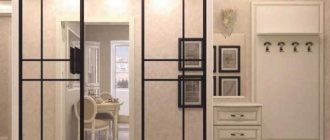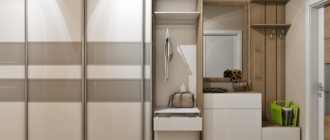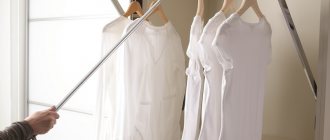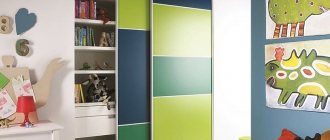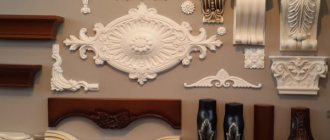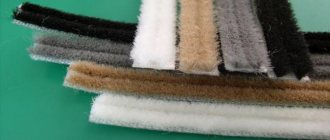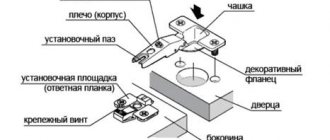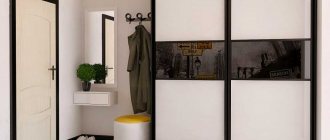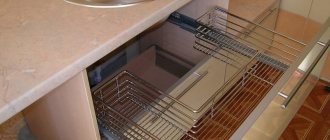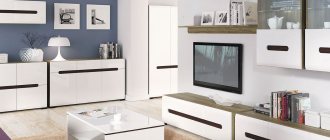Properly organized clothing storage is not only a way to ensure order in the house, but also an opportunity to extend the life of your favorite things. Dresses, suits, skirts, hung on special hangers and placed in wardrobes, will not require additional effort from their owner to return them to their proper appearance. Furniture should be as functional and comfortable as possible. You need to choose it carefully, taking into account not only the dimensions of the room, but also the purpose of the room, be it a bedroom, a nursery or a hallway.
Advantages of a dressing room in the hallway
Modern people do not always have a lot of free time. A dressing room in the hallway will save it. When everything is at your fingertips, it's easier to be organized and punctual.
The dressing room is the best place to store things in a modern apartment Source design-homes.ru
Let's look at the main advantages of such storage:
- saving space, you can get rid of bulky wardrobes in the bedroom;
- if the dressing room is equipped with a mirror, this is functional, plus the corridor space visually expands;
- with the help of a dressing room you can put out of sight: the control panel for the security alarm system, a safe, an electric meter, a key holder;
- a good place to store seasonal clothing and sports items;
- in a large model you can even place household paraphernalia: a vacuum cleaner, a mop, a broom;
- An interesting dressing room design fills the hallway with new colors and complements the interior of the room.
It’s good when there is enough space for a dressing room in the hallway, you can experiment with the design of sliding doors for the design Source design-homes.ru
Rushing to work in the cold season, you can forget where your favorite scarf is, suitable for your handbag. This situation will never happen if all things are in one place.
A sliding wardrobe is also appropriate in an oriental style hallway, the main thing is to choose the right door decor Source design-homes.ru
Varieties and forms
Today, a large number of wardrobe options have been developed that are designed for different rooms. Depending on the shape, furniture is divided into angular and straight. A corner wardrobe allows you to make maximum use of the space in the room. The problem of saving space is solved by having structures with both external and internal corners.
Tips for arranging wardrobes in an apartment
As for the shape of the cabinets, they can be made in the form of semicircular or triangular structures, as well as trapezoids. Not every apartment or house can accommodate a stock model of cabinet; in some cases, you have to order custom-made furniture for a specific space.
Straight cabinets are a classic. Manufacturers offer a large number of sizes, so that almost anyone who is thinking about installing such a product will choose an option to suit their needs and the available space.
Depending on the placement method, furniture is divided into two types:
- free-standing;
- built-in
The first option is convenient because the cabinet can be easily moved to another location. The downside is that the product takes up a lot of space. The built-in wardrobe storage system is the maximum use of room space, various options for internal configuration. These cabinets have a wide range of opening systems: from fabric curtains to folding doors.
Built-in furniture is always an individual approach to solving the owner’s problem of arranging things and clothes. There are no ready-made versions of such systems; furniture must be made to order. This is a disadvantage, since you will have to wait until the cabinet is designed, manufactured, and installed. The cost of such structures is much higher than ready-made options. The advantage is that the design and dimensions of wardrobes are selected according to the customer’s parameters. This furniture fits perfectly into the existing interior.
Straight
Semicircular
Triangular
Trapezoid
Standing separately
Built-in
Wardrobe layout
At its core, a dressing room is an ordered system of shelves, rails, baskets and racks, providing maximum visibility of the items located in it, which fundamentally distinguishes it from the dark and cluttered closets typical of many Soviet apartments. Usually in small apartments the role of a dressing room is played by a wardrobe or a corner wardrobe, but a full-fledged dressing room has a number of significant advantages over them.
Layout options for a small L-shaped dressing room, Adielle
Size options
Wardrobes have standard measurements: height, width and depth. They should be carefully studied before purchasing furniture. The height is usually 210–240 cm (depending on the internal structure). The more space allocated for storing clothes on hangers, the higher the product will be (at least 190 cm). The presence of upper mezzanine shelves or lower ones for shoes will further increase the height of the cabinet (up to 2.5 m).
The width is determined by the number of doors. If we take into account that one door has a size of 43–45 cm, then the finished cabinets will have the following dimensions:
- Single door up to 45 cm.
- Two-door up to 90 cm.
- Large three-door up to 135 cm.
Types of sliding doors for a dressing room, assembly features
The depth of the structure is determined by the purpose of the cabinet. If it is needed to store clothes on hangers, then this figure should be at least 55–60 cm. If such a department is not provided in the design, then the depth can be only 40 cm. The given dimensions do not apply to built-in models installed in dressing rooms , or options made to order.
Drawers and shelves
A closed variety is preferable as it does not allow dust to pass through. Large containers can accommodate both linen and bedding.
Compact drawers will contain jewelry and accessories and have special dividers. Shelves with a width of 30-40 cm are tightly fixed, folded or pulled out.
Mezzanines are made wider for dimensional attributes.
Opening systems
The ease of use of the dressing room largely depends on the door opening system. The swing is a timeless classic. The doors are mounted on the side walls of the structure and have comfortable handles. To open, you need to grab them and pull them towards you. The system has its advantages: affordable cost, good visibility of shelves, long service life. The disadvantage is that installing such a cabinet requires additional space (for open doors).
Coupe is a modern version of the design, when the doors are located on the upper and lower runners and, when opened, slide one behind the other. Disadvantages of such a system:
- High price.
- With low-quality components and mechanisms, there is noise when opening and a short service life.
- Some of the shelves closed by the doors are not visible; you will have to move the doors in the other direction.
The main advantage of a sliding wardrobe in a dressing room is space saving, since opening doors do not require additional space, as in a swing system. Thanks to its compactness, you can install the product in any room, hallway and even bedroom.
Accordion is a system in which the doors consist of several panels connected to each other and moving along the upper guide bar, like the bellows of a musical instrument - an accordion. Often used in corner structures. Advantages: ease of use, accessibility of all shelves and cabinet compartments, interesting design solution. Cons: a little additional space is required, the doors are poorly fixed, since they move not along two guides, but along one.
The next option for installing wardrobe doors is a combined one, which requires the presence of at least 2 types of doors with different opening mechanisms. Sliding wardrobes, consisting of two modules, can have a system that uses sliding and hinged doors.
Swing
Coupe
Harmonic
Combined
Color palette
It is known that color directly affects a person’s emotional state, so the key factor when creating a dressing room is its color. Of course, first of all, experts recommend focusing on the color scheme of the room itself.
For a bedroom, as a rule, designers recommend creating the same type of palette without sharp transitions. You can also use a harmonious palette, which involves a balance of organically combined shades. For example, if the room is made in yellow and light green, a wardrobe in the bedroom in brown or camel color will look good.
Materials and design
To increase the functionality of the dressing room, a large number of internal elements are used. These are systems for hanging things: rods and pantographs for long and short clothes. Short metal rods or wooden slats are used for skirts or trousers. Open modules designed for hallways use hooks or rods.
Another important part of the closet and dressing rooms are the shelves. As a rule, they are made from the same material as the furniture itself. But here, too, options are possible. Instead of the usual chipboard or MDF, plastic can be used.
One of the essential elements of a convenient storage system is drawers. There may be plastic pull-out boxes in the dressing room or closet. The internal organization of the box varies. The box may be empty, or its space may be divided by partitions: hard wood, plastic, or even soft fabric dividers. In addition to drawers, metal or fabric baskets are a common element of a dressing room.
How to make a dressing room in a Khrushchev-era building instead of a storage room, photos and ideas
Wardrobe cabinet fronts are made from different types of materials. The most commonly used are wood, chipboard and MDF panels, which can be painted or covered with PVC film. Thanks to the wide range of colors, you can choose furniture to match the existing design of the room. The decor also varies:
- A mirror is especially in demand in hallways. Often chosen for small rooms because it can visually expand the space. To increase the safety of use, manufacturers apply an anti-shock film to the mirror surface, which prevents fragments from scattering if broken.
- Opaque glass, a varnish, does not allow you to fully see all the contents of the cabinet, but the general outlines of its contents are visible. Interesting design solution.
- Plastic is an inexpensive material and can be transparent, translucent or tinted.
- The fabric that functions as a curtain is practical, easy to wash, and creates additional comfort. It is not suitable for every room and does not fit into most design concepts, so it is often used when arranging separate dressing rooms.
- Bamboo or rattan is a solution for those who love ethnic style in room design and use natural materials when decorating a house or apartment.
- Natural or artificial leather makes the furniture look more expensive.
The service life of the product depends on the quality of the materials used. Between chipboard, MDF and wood, preference should be given to the latter. This is an expensive but practical option that will definitely last a long time.
Tree
Chipboard
MDF
Mirror
Opaque glass
Plastic
Textile
Bamboo
Leather
Filling your closet
Of primary importance is the competent and thoughtful filling of the dressing room, especially since the market today offers a very large number of different designs designed for the most functional and visual filling of dressing rooms.
Unusual cubic shelves for a dressing room in loft or grunge styles, Shake
Recommendations for selection
Before you start looking for a wardrobe, it is worth assessing the room in which it will be installed. Choose a place to place it, for example, along a wall or in the corner of a room. Next you need to decide on the optimal size of the furniture. The closet should be installed so that it can be easily approached, it does not interfere with movement around the room, and its spaciousness makes it possible to solve the problem of storing the required number of things.
When the introductory conditions have been assessed and the dimensions have been determined, you can begin choosing a specific model, paying attention to the following points:
- The quality of the material, the absence of defects, scratches, abrasions that could worsen the appearance of the furniture.
- Functioning of opening and closing systems: presence of noise, tightness of doors.
- Components for cabinets: are there door closers that ensure soft closing of the doors, how comfortable are the handles, how does the lighting function.
- To what extent the internal structure of the closet will allow you to organize proper storage, what things can fit in the dressing room.
- The appropriateness of using fittings, whether they spoil the appearance of the furniture.
- Will the new furnishing element fit into the overall design idea of the room?
By following these simple rules, you can determine what is best to choose for a dressing room, allocated to a separate room, or for installing a closet. Thanks to the storage system, clothes and things will be neatly placed, protected from dust and retain their shape. One floor-to-ceiling wardrobe can replace several small wardrobes.
Material quality
Operation of opening and closing systems
Cabinet accessories
Internal organization
Accessories
Design
Structural elements
In addition to the base of the system (frame), additional components are used for assembly. Such elements include rods, shelves, drawers, boxes. Not so popular, but also often used, are trousers. All of the listed methods of storing things for a dressing room have their own characteristics, and most importantly, parameters.
Bars and pantographs
The main elements of the wardrobe system include a bar on which hangers are placed. Part parameters are selected according to the size of the internal space. The length is equal to the width of the compartment in which the bar is installed, and it should be within 80–90 cm. The placement height depends on the items being stored:
- for coats, fur coats, long jackets or dresses - no less than 165 cm;
- for shirts, blouses and other short clothes - about 100–150 cm;
- when installing rods in two tiers for storing short items - 100 cm between them.
Types of wardrobe hangers, reasons for popularity
Pantographs are used in spacious and fairly high storage systems for dressing rooms. These elements allow horizontally located rods to be lowered or raised to the upper tier.
In shallow cabinets, it is better to install a retractable rod instead of a pantograph.
Shelves
Shelves are considered one of the main elements of most wardrobe storage systems. They are made from MDF or laminated chipboard - lightweight, relatively inexpensive and durable materials. The shelf can withstand a lot of weight and allows you to place a lot of things. Glass and plastic models are chosen for lightweight small items, mesh models are chosen for shoes, suitcases or bags.
Recommended shelf sizes:
- depth - within 35–60 cm (depending on the depth of the system itself);
- width - from 40 to 100 cm, if the size is more than 80 cm, it is recommended to provide a partition at the bottom to avoid sagging;
- The height distance between the shelves is 30–40 cm.
The element can be retractable, folding or removable. The most popular first option. Unlike a drawer, a folding shelf similar in operating principle provides not only open access, but also the ability to easily find the things you need in the wardrobe.
Retractable
Folding
Removable
Boxes
Mesh or closed drawers are components for wardrobe systems, suitable for storing clothes and all kinds of accessories (gloves, belts). The elements are secured using brackets, and special guides are used for movement. Locking mechanisms help prevent the drawers from completely rolling out.
The size and number of drawers depend on the needs of the wardrobe owner:
- the optimal width of the element is from 40 to 70 cm;
- height - from 15 to 40 cm;
- distance above floor level - 110–140 cm.
The use of these pull-out wardrobe storage systems is recommended for accessories or decorations that need to be protected from dust.
To ensure that there is always order inside the drawers and that every item is in its place, dividers are used - usually made of the same material.
Mesh
Closed
Trouser hangers
Pants are also used as components for wardrobe systems. They are several parallel rods fixed on one side. The vertical arrangement allows you to store trousers, scarves, ties or scarves in perfect condition, saving time on ironing. The elements can be foldable, in which case they take up very little space inside the system.
In most respects, the skirt is no different from the trouser. The only difference is the greater thickness of the rod and the presence of special clips that hold the skirts vertically. Both types of hangers are placed at a height of at least 600 mm from the floor of the wardrobe system; their width is equal to the compartment in which they are located - usually no more than 800 mm.
Baskets and boxes
The sizes and colors of boxes (baskets) depend on the type of system and its purpose. They are made from plywood, cardboard or plastic. The type of elements usually corresponds to the design of the system, but may differ to obtain original design solutions. The main advantage of the basket is the ability to immediately see what is inside. At the same time, you can place things of any size in the box.
The width of baskets and boxes is usually in the range of 25–90 cm. The parameters should be slightly smaller than the shelves on which they are installed. Depth - from 8 to 28 cm. Height - no more than 38–40 cm. If we are talking about cellular baskets, the dimensions of square cells can start from 2 x 2 mm and end at 20 x 20 mm.
Style
Of course, the dressing room in the bedroom should match the style of the room itself. Let's introduce some basic aspects and properties of styles.
- High-tech, loft - if the room is made in these styles, when arranging the dressing room you should use mirrors or tinted glass, the color palette or pattern should match the walls. This is a modern dressing room in the bedroom, characterized by laconicism and originality.
- Classicism and neoclassicism are distinguished by an abundance of straight lines and pointed corners.
- Minimalism - this style is characterized by simplicity and practicality. As a rule, the decor is not replete with a large number of intricate elements.
- Rustic is a sophisticated style that not every family can afford, since it requires the use of natural, high-quality materials. But these costs are compensated by the magnificent appearance.
- Pop art - this style manifests itself in bright, colorful colors and natural finishes.
